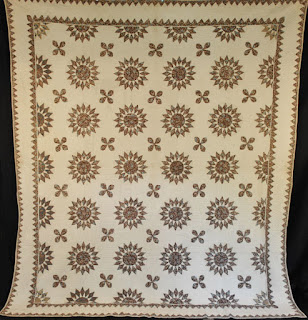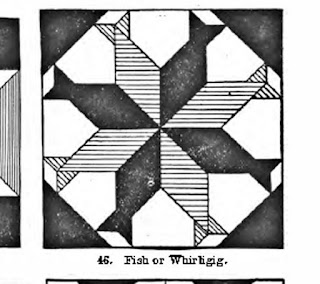Detail of a quilt made by Zella Ingram in Dayton, Ohio
found by the West Virginia Project. Photo from the Quilt Index.
Zella's quilt looks to be about 1910. The pattern is
fascinating (to those of us fascinated by pattern). I can't find it
in BlockBase although it has relatives, including the Improved Nine Patch
See this weeks Cloud of Quilt Patterns post on that design at this link:
You first see a circle and a sort of lozenge shape, a squeezed square, but
she pieced it as a square block.
The block alternates with a plain white block. I drew it in EQ.
It looks do-able, especially if it were pieced over paper.
So how did I draw that pattern for a design that has no BlockBase number?
I'm not that good at drawing curves and complex structures in EQ. If it's more than a 9-patch I usually import a pattern from BlockBase and use that structure. Then erase and/or add lines.
So I found the nearest thing with the same basic proportions.
Far More Complex
It's a curved shape in a block.
Chimney Swallow from Clara Stone about 1900.
2691a or 2691b
A pattern with a lot of names in a design that hardly anybody ever made.
Well, Carrie Hall made one block.
From her block collection at the Spencer Museum of Art.
I imported BlockBase 2691a into Electric Quilt and erased a lot of lines.
Voila!
Print this on an 8-1/2" x 11" sheet of paper for a pattern
for an 8" block.
I really couldn't find any vintage examples of the more complex 2691---Chimney Swallows. When I did a search in the Quilt Index no vintage quilts came up. But this impressive 21st-century quilt was recorded in the Arizona project.
Swallows in the Garden by Karen Bogardi
Another pattern structure is to do it as an all-over design with no square block. It looks like
that's the way Karen did her Chimney Swallows.
And here's an early 20th century variation done that way.
Seam lines?
Very cool how the corners make a design going north/south and the
centers make the same design on a diagonal.
http://www.quiltindex.org/fulldisplay.php?kid=50-8A-CC4
Karen's here
http://www.quiltindex.org/fulldisplay.php?kid=67-EC-9A2
And look at the new EQ8 here:
http://electricquilt.com/online-shop/category/electric-quilt-8-eq8/
























































